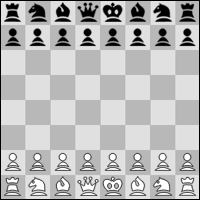
Article
2: The initial position of the pieces
on the chessboard
2.1
The chessboard is composed of an 8x8 grid of 64 equal squares alternately
light (the 'white' squares) and dark (the 'black' squares).
The chessboard
is placed between the players in such a way that the near corner square
to the right of the player is white.
2.2
At the beginning of the game one player has 16 light-coloured pieces (the
'white' pieces); the other has 16 dark-coloured pieces (the 'black' pieces):
These pieces are as follows:
| A white king, usually indicated by the symbol | |
| A white queen, usually indicated by the symbol | |
| Two white rooks, usually indicated by the symbol | |
| Two white bishops, usually indicated by the symbol | |
| Two white knights, usually indicated by the symbol | |
| Eight white pawns, usually indicated by the symbol | |
| A black king, usually indicated by the symbol | |
| A black queen, usually indicated by the symbol | |
| Two black rooks, usually indicated by the symbol | |
| Two black bishops, usually indicated by the symbol | |
| Two black knights, usually indicated by the symbol | |
| Eight black pawns, usually indicated by the symbol |
2.3
The initial position of the pieces on the chessboard is as follows:

2.4 The eight vertical columns of squares are called 'files'. The eight horizontal rows of squares are called ranks'. A straight line of squares of the same colour, touching corner to corner, is called a 'diagonal'.